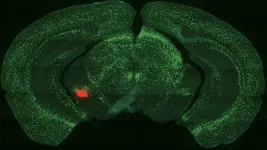(Press-News.org) Galaxies grow and evolve by merging with other galaxies, blending their billions of stars, triggering bursts of vigorous star formation, and often fueling their central supermassive black holes to produce luminous quasars that outshine the entire galaxy. Some of these mergers eventually go on to become massive elliptical galaxies that contain black holes that are many billions of times the mass of our Sun. Although astronomers have observed a veritable menagerie of merging galaxies with more than one quasar in our own cosmic neighborhood, more distant examples, seen when the Universe was only a quarter of its current age, are quite rare and extremely challenging to find.
By harnessing a bevy of ground- and space-based observatories — including Gemini North, one half of the International Gemini Observatory, operated by NSF’s NOIRLab — a team of astronomers has discovered a closely bound pair of actively feeding supermassive black holes — quasars. This discovery is the first confirmed detection of a pair of supermassive black holes in the same galactic real estate at ‘cosmic noon’ — a period of frenetic star formation at a time when the Universe was only three billion years old.
Previous observations have identified similar systems in the early stages of merging, when the two galaxies could still be considered clearly separate entities. But these new results show a pair of quasars blazing away in such close proximity, a mere 10,000 light-years apart, that their original host galaxies are likely well on their way to becoming a single giant elliptical galaxy.
Searching for pairs of supermassive black holes so close to each other during this early epoch is like trying to find the proverbial needle in a haystack. The challenge is that most black-hole pairs are too close to distinguish individually. To definitively detect such a system, the two supermassive black holes need to be actively accreting and shining as quasars simultaneously, conditions that are extremely rare. Statistically, for every 100 supermassive black holes only one should be actively accreting at a given time.
Astronomers know, however, that the distant Universe should be brimming with pairs of supermassive black holes embedded within merging galaxies. The first hints of such a system were found in data from the NASA/ESA Hubble Space Telescope, which revealed two closely aligned pinpoints of light in the distant Universe.
To verify the true nature of this system, the team searched through ESA’s Gaia observatory’s vast database and found that this system had an apparent “jiggle,” which could be the result of sporadic changes in a black hole's feeding activity.
The team then used the Gemini Multi-Object Spectrograph (GMOS) and GNIRS on Gemini North, which provided the team with independent measurements of the distance to the quasars and confirmed that the two objects were both quasars rather than a chance alignment of a single quasar with a foreground star. Further studies with the W.M. Keck Observatory, NSF’s Karl G. Jansky Very Large Array, and NASA’s Chandra X-ray Observatory also helped to confirm these observations.
“The confirmation process wasn’t easy and we needed an array of telescopes covering the spectrum from X-rays to the radio to finally confirm that this system is indeed a pair of quasars, instead of, say, two images of a gravitationally lensed quasar,” said co-author Yue Shen, an astronomer at the University of Illinois.
“We don't see a lot of double quasars at this early time. And that's why this discovery is so exciting. Knowing about the progenitor population of black holes will eventually tell us about the emergence of supermassive black holes in the early Universe, and how frequent those mergers could be,” said graduate student Yu-Ching Chen of the University of Illinois at Urbana-Champaign, lead author of this study, which is published in the journal Nature.
More information
NSF’s NOIRLab, the US center for ground-based optical-infrared astronomy, operates the International Gemini Observatory (a facility of NSF, NRC–Canada, ANID–Chile, MCTIC–Brazil, MINCyT–Argentina, and KASI–Republic of Korea), Kitt Peak National Observatory (KPNO), Cerro Tololo Inter-American Observatory (CTIO), the Community Science and Data Center (CSDC), and Vera C. Rubin Observatory (operated in cooperation with the Department of Energy’s SLAC National Accelerator Laboratory). It is managed by the Association of Universities for Research in Astronomy (AURA) under a cooperative agreement with NSF and is headquartered in Tucson, Arizona. The astronomical community is honored to have the opportunity to conduct astronomical research on Iolkam Du’ag (Kitt Peak) in Arizona, on Maunakea in Hawai‘i, and on Cerro Tololo and Cerro Pachón in Chile. We recognize and acknowledge the very significant cultural role and reverence that these sites have to the Tohono O’odham Nation, to the Native Hawaiian community, and to the local communities in Chile, respectively.
Links
Nature paper "A Close Quasar Pair in a Disk-Disk Galaxy Merger at z = 2.17"
Photos of Gemini North
Videos of Gemini North
Hubble version of news release END
Dual quasars blaze bright at the center of merging galaxies
Gemini North helps confirm nature of cosmic system on the verge of becoming a giant elliptical galaxy
2023-04-05
ELSE PRESS RELEASES FROM THIS DATE:
SFU research aids fight against treatment-resistant superbugs
2023-04-05
Researchers at Simon Fraser University are studying the genes of superbugs to aid the development of new and effective treatments for drug-resistant bacterial infections. Superbugs are characterized as infection-causing bacteria resistant to treatment with antibiotics.
“Antimicrobial resistance occurs when the disease-causing bacteria has ways to overcome the antibiotics that we use in treatment for infections,” says assistant professor Amy Lee, of SFU's Department of Molecular Biology and Biochemistry. The initiative is a collaboration between the Lee Lab and Brinkman Lab, which are working together as ...
Underground water could be the solution to green heating and cooling
2023-04-05
About 12% of the total global energy demand comes from heating and cooling homes and businesses. A new study suggests that using underground water to maintain comfortable temperatures could reduce consumption of natural gas and electricity in this sector by 40% in the U.S. The approach, called aquifer thermal energy storage (ATES), could also help prevent blackouts caused by high power demand during extreme weather events.
“We need storage to absorb the fluctuating energy from solar and wind, and most people are interested in batteries ...
WVU researchers earn $8M for rare earth extraction facility, an economic and environmental game changer
2023-04-05
West Virginia University researchers will continue to develop and advance their pioneering method to extract and separate rare earth elements and critical minerals from acid mine drainage and coal waste, courtesy of $8 million in new funding from the U.S. Department of Energy.
The grant, part of President Joe Biden’s Investing in America agenda, will lead to the design, construction and operation of a pre-commercial demonstration facility for separating and refining rare earth elements and critical minerals, according to Paul Ziemkiewicz, project lead and director of the West Virginia Water ...
Danger or pleasure? How we learn to tell the difference
2023-04-05
Deep within our brain’s temporal lobes, two almond-shaped cell masses help keep us alive. This tiny region, called the amygdala, assists with a variety of brain activities. It helps us learn and remember. It triggers our fight-or-flight response. It even promotes the release of a feel-good chemical called dopamine. Scientists have learned all this by studying the amygdala over hundreds of years. But we still haven’t reached a full understanding of how these processes work.
Now, Cold Spring Harbor Laboratory neuroscientist Bo Li has brought us several important steps closer. His lab recently made a series of discoveries ...
Ice sheets can collapse faster than previously thought possible
2023-04-05
Ice sheets can retreat up to 600 metres a day during periods of climate warming, 20 times faster than the highest rate of retreat previously measured.
An international team of researchers, led by Dr Christine Batchelor of Newcastle University, UK, used high-resolution imagery of the seafloor to reveal just how quickly a former ice sheet that extended from Norway retreated at the end of the last Ice Age, about 20,000 years ago.
The team, which also included researchers from the universities of Cambridge and Loughborough in the UK and the Geological Survey of Norway, mapped more than 7,600 small-scale landforms called ‘corrugation ridges’ across the seafloor. The ridges ...
Chinese researchers achieve superionic hydride ion conduction at ambient temperatures
2023-04-05
Materials that can conduct negatively charged hydrogen atoms in ambient conditions would pave the way for advanced clean energy storage and electrochemical conversion technologies. A research team from the Dalian Institute of Chemical Physics (DICP) of the Chinese Academy of Sciences (CAS) demonstrated a technique that enables a room-temperature all-solid-state hydride cell by introducing and exploiting defects in the lattice structure of rare earth hydrides.
Their study was published in Nature on April 5.
Solid materials ...
Therapy for babies with signs of autism cuts long-term disability costs
2023-04-05
New research evaluating the potential cost savings of a therapy for babies displaying early autism signs has predicted a three dollar return to Australia’s National Disability Insurance Scheme (NDIS) for every dollar invested in therapy.
Published in the prestigious JAMA Network Open, the health economic study drew on the results of a landmark multi-centre randomised clinical trial which reported the world’s first evidence that a therapy commenced in infancy (iBASIS-VIPP)* could reduce early developmental disability to the point where a childhood clinical autism diagnosis was two-thirds ...
CHOP researchers reveal complex assembly process involved in DNA virus replication
2023-04-05
Philadelphia, April 5, 2023—In a twist on the question, “Which came first, the chicken or the egg?”, scientists have long faced a similar question about how human adenovirus replicates: “Which comes first, assembly of the viral particle, or packaging of the viral genome?” Now, in a new study published today in Nature, researchers at Children’s Hospital of Philadelphia (CHOP) have answered that question, showing that viral proteins use a process called phase separation to coordinate production ...
Trends in suicidal thoughts, behaviors among veterans during pandemic
2023-04-05
About The Study: The prevalence of suicidal thoughts and behaviors has not increased for most U.S. veterans during the first three years of the COVID-19 pandemic. However, veterans with pre-existing loneliness, psychiatric distress, and lower purpose in life were at heightened risk of developing new-onset suicidal ideation and suicide planning during the pandemic. Evidence-based prevention and intervention efforts that target these factors may help mitigate suicide risk in this population.
Authors: Ian C. Fischer, Ph.D., of the ...
Historical redlining, social determinants of health, and stroke prevalence in communities in New York City
2023-04-05
About The Study: This study found that historical redlining was associated with modern-day stroke prevalence in New York City independently of contemporary social determinants of health and community prevalence of some relevant cardiovascular risk factors.
Authors: Benjamin M. Jadow, B.A., of the Albert Einstein College of Medicine in Bronx, New York, is the corresponding author.
To access the embargoed study: Visit our For The Media website at this link https://media.jamanetwork.com/
(doi:10.1001/jamanetworkopen.2023.5875)
Editor’s Note: Please see the article ...
LAST 30 PRESS RELEASES:
This new understanding of T cell receptors may improve cancer immunotherapies
A new fossil face sheds light on early migrations of ancient human ancestor
A new immunotherapy approach could work for many types of cancer
A new way to diagnose deadly lung infections and save lives
40 percent of MRI signals do not correspond to actual brain activity
How brain-inspired algorithms could drive down AI energy costs
Gum disease may be linked to plaque buildup in arteries, higher risk of major CVD events
Contrails are a major driver of aviation’s climate impact
Structure of dopamine-releasing neurons relates to the type of circuits they form for smell-processing
Reducing social isolation protects the brain in later life
Keeping the heart healthy increases longevity even after cancer
Young adults commonly mix cannabis with nicotine and tobacco
Comprehensive review illuminates tau protein's dual nature in brain health, disease, and emerging psychiatric connections
Book prepares K-12 leaders for the next public health crisis
Storms in the Southern Ocean mitigates global warming
Seals on the move: Research reveals key data for offshore development and international ecology
Sports injuries sustained during your period might be more severe
World's first successful 2 Tbit/s free-space optical communication using small optical terminals mountable on satellites and HAPS
Can intimate relationships affect your heart? New study says ‘yes’
Scalable and healable gradient textiles for multi‑scenario radiative cooling via bicomponent blow spinning
Research shows informed traders never let a good climate crisis go to waste
Intelligent XGBoost framework enhances asphalt pavement skid resistance assessment
Dual-function biomaterials for postoperative osteosarcoma: Tumor suppression and bone regeneration
New framework reveals where transport emissions concentrate in Singapore
NTP-enhanced lattice oxygen activation in Ce-Co catalysts for low-temperature soot combustion
Synergistic interface engineering in Cu-Zn-Ce catalysts for efficient CO2 hydrogenation to methanol
COVID-19 leaves a lasting mark on the human brain
Scientists use ultrasound to soften and treat cancer tumors without damaging healthy tissue
Community swimming program for Black youth boosts skills, sense of belonging, study finds
Specific depressive symptoms in midlife linked to increased dementia risk
[Press-News.org] Dual quasars blaze bright at the center of merging galaxiesGemini North helps confirm nature of cosmic system on the verge of becoming a giant elliptical galaxy







